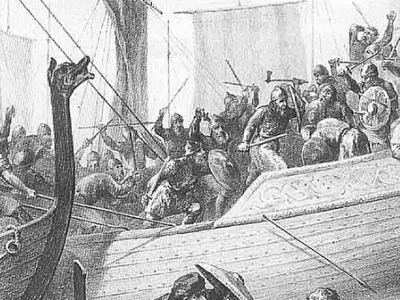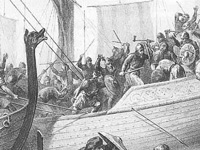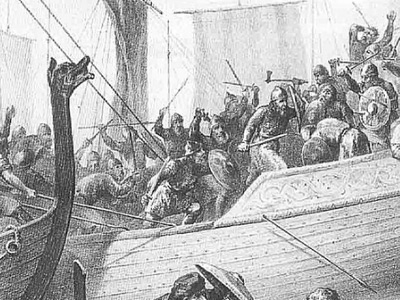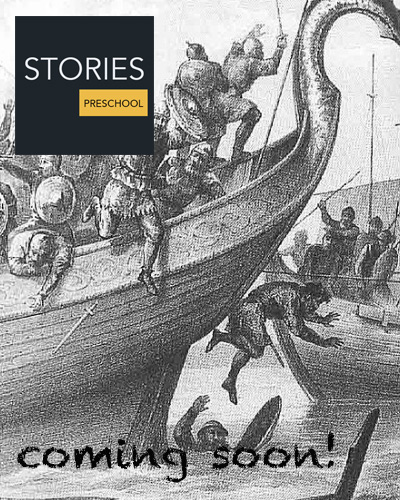Battle of Svolder (1000)

The Battle
The disposition adopted in the battle was one which recurs in many sea-fights of the Middle Ages where a fleet had to fight on the defensive. Olaf lashed his ships side to side, with his own, the Long Serpent, in the middle of the line, where her bows projected beyond the others. The advantages of this arrangement were that it left all hands free to fight, that a barrier could be formed with the oars and yards, and that it limited the enemy's ability to make its superior numbers count. The Long Serpent was the longest ship and so also the tallest—another advantage to the defenders, who could rain down arrows, javelins and other missiles while the enemy would have to shoot upwards. Olaf, in effect, turned his eleven ships into a floating fort.
The sagas give all the credit to the Norwegians, praising Eirik Hákonarson for any intelligence and for most of the valour shown by Olaf Tryggvason's opponents. The Danes and Swedes rush at the front of Olaf's line and are repulsed, suffering heavy casualties and loss of ships. Jarl Eirik attacks the flank and forces his vessel, the Iron Ram, up against the last ship of Olaf's line, which he clears with a fierce attack and then proceeds onto the next ship. In this way, Olaf's ships were cleared one by one, till the Long Serpent alone was left.
Einarr Þambarskelfir
One of the best known episodes from the battle involves Einarr Þambarskelfir, an archer in King Olaf's fleet who later became a cunning politician. Heimskringla describes his attempt at killing Jarl Eirik and saving the day for Olaf:
Einar shot an arrow at Earl Eirik, which hit the tiller end just above the earl's head so hard that it entered the wood up to the arrow-shaft. The earl looked that way, and asked if they knew who had shot; and at the same moment another arrow flew between his hand and his side, and into the stuffing of the chief's stool, so that the barb stood far out on the other side. Then said the earl to a man called Fin, -- but some say he was of Fin (Laplander) race, and was a superior archer, -- "Shoot that tall man by the mast." Fin shot; and the arrow hit the middle of Einar's bow just at the moment that Einar was drawing it, and the bow was split in two parts.
"What is that", cried King Olaf, "that broke with such a noise?"
"Norway, king, from thy hands," cried Einar.
"No! not quite so much as that," says the king; "take my bow, and shoot," flinging the bow to him.
Einarr took the bow, and drew it over the head of the arrow. "Too weak, too weak," said he, "for the bow of a mighty king!" and, throwing the bow aside, he took sword and shield, and fought valiantly.
The same story is found in Gesta Danorum, though there Einarr is aiming at Svein, rather than Eirik.
King Olaf's death
At last, the Long Serpent is overpowered and Olaf Tryggvason defeated. The Danish sources report that when all was lost he committed suicide by throwing himself into the sea, "the end befitting his life", according to Adam of Bremen. Saxo Grammaticus says that Olaf preferred suicide to death at the hands of the enemy and jumped overboard in full armour rather than see his foes victorious. The Norwegian and Icelandic accounts are more complex and more favourable to Olaf. Hallfreðr's memorial poem for his lord had already alluded to rumours that Olaf escaped death at Svolder. The sagas offer a variety of possibilities. Ágrip reports:
"But of the fall of King Óláfr nothing was known. It was seen that as the fighting lessened he stood, still alive, on the high-deck astern on the Long Serpent, which had thirty-two rowing places. But when Eiríkr went to the stern of the ship in search of the king, a light flashed before him as though it were lightning, and when the light disappeared, the king himself was gone."
Other sagas suggest that one way or another Olaf made his way to the shore; perhaps by swimming, perhaps with the help of angels, most likely rescued by one of the Wendish ships present. After his escape, Olaf supposedly sought salvation for his soul abroad, perhaps joining a monastery. Mesta describes a series of "sightings" of him in the Holy Land, the last in the 1040s.
King Olaf, like Charlemagne, Frederick Barbarossa and Sebastian of Portugal, is one of those legendary heroic figures whose return was looked for by the people, their deaths never completely accepted.
HISTORY

RESOURCES
This article uses material from the Wikipedia article "Battle of Svolder (1000)", which is released under the Creative Commons Attribution-Share-Alike License 3.0.
© Stories Preschool. All Rights Reserved.









